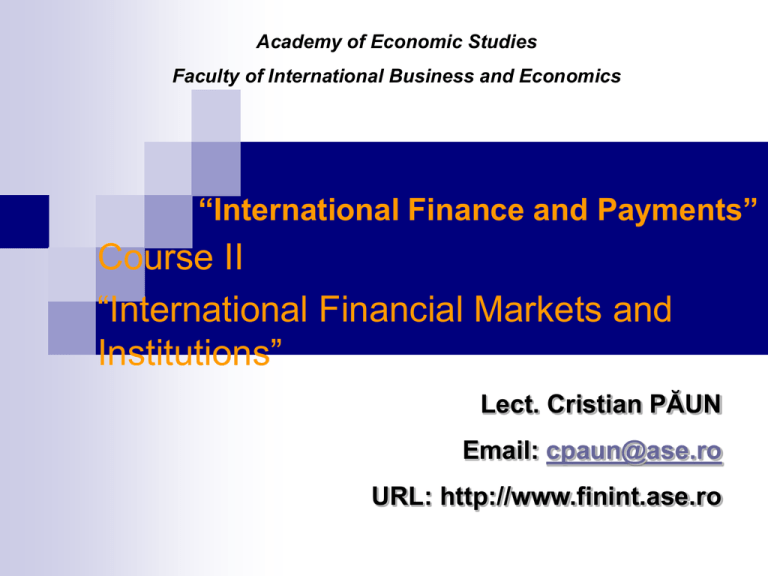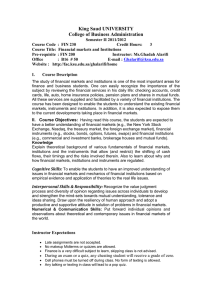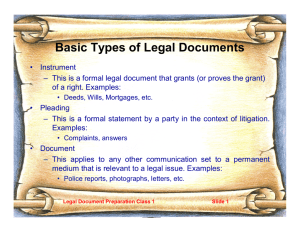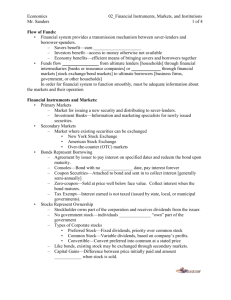CURS: “TEHNICA PLĂŢILOR ŞI FINANŢĂRII INTERNAŢIONALE”
advertisement

Academy of Economic Studies Faculty of International Business and Economics “International Finance and Payments” Course II “International Financial Markets and Institutions” Lect. Cristian PĂUN Email: cpaun@ase.ro URL: http://www.finint.ase.ro International Financial System - review • IFS ensures the capital transfers between the investors and financing beneficiaries (or debtors) – main function; • IFS is composed by financial markets, financial institutions and financial instruments; • Bretton Woods Agreement is the base for actual IFS; • the evolution of IFS was determined by several factors; • EMS was an European alternative for IFS; • BP registers all the commercial and financial transactions of a country with the rest of the World; • we use this BP to determine the need for financial resources for a country • this BP should be in equilibrium and the deficits can be reduced using different policies; • the fixed exchange rate ensures an automatic equilibrium for a BP. Course 2: International Financial Markets and Institutions 2 Financial System - structure Financial transactions Private companies Government Financial Financial transactions Institutions Population Course 2: International Financial Markets and Institutions Financial transactions Financial Markets 3 Financial Markets - characteristics FINANCIAL MARKETS Money Markets (maturity < 1 year): -very liquid; - transactions with credit instruments; - small fluctuations for the securities prices => low risk Capital Markets (maturity > 1 year): - transactions with debt and equity securities (bonds, equities) - higher prices fluctuations International Credit Markets, Euromarkets and FX Markets -Primary market: is a financial market in which new issues of a security are sold to initial buyers; - Secondary market: is a financial market in which security (previously issued) can be resold by the investors for cash. Exchange offices (NYSE, CBOT) OTC Markets Course 2: International Financial Markets and Institutions 4 Financial Markets - characteristics Characteristics Money Markets Capital Markets Maturity Under 1 year Below 1 year Risks Lower Higher Instruments Credit instruments Debt and Equity instruments Liquidity Higher Lower Transaction volume Lower Higher Credit instruments Debt and Equity Instruments - Treasury bills; - Common Stocks - Commercial Papers; - Preferred Stocks - Banker’s Acceptance; - Bonds - DC; - Investment Funds Participations - Credits; - Insurance Policies - Pension Funds Policies - Derivatives Course 2: International Financial Markets and Institutions 5 Financial Resources for a company Internal Resources - Reinvesting the profits; - Increasing capital; -Debt to equity conversion; - Amortization. Financing Decision External Resources - Credits; - Bond issuing; - Equity. Course 2: International Financial Markets and Institutions 6 Why we should use internal resources ? Advantages: • increase the company value; • higher autonomy from financial institutions; • lower costs (such as banking commissions and taxes); • advantages from fiscal regimes applied to reinvested profits; • small companies or new business; • leveraged companies (high debt). Disadvantages: • opportunity costs; Real cost for internal financial resources • taxation. Internal resources are the most expensive financial resources !!! Course 2: International Financial Markets and Institutions 7 Why we should use external resources ? Advantages: • mature business – “cash-flow cows”; • less costly then own financial resources; • important financial resources that can be obtained; • higher maturity; • fiscal regimes in case of the interest paid to a bank; Disadvantages: • additional costs (taxes, commissions applied); • the dependence from the financial institutions; • the reimbursement program; • a good projection for your business development (future income and cashflow prediction). Course 2: International Financial Markets and Institutions 8 Direct Financing vs. Indirect Financing Financial Intermediaries Indirect Financing Debtor (Beneficiary) Investor or Creditor Direct Financing Course 2: International Financial Markets and Institutions 9 Direct Financing vs. Indirect Financing Advantages for indirect financing: • a good information about capital resources; • lower risks (some institutions share or cover the financial risks); • financing consultancy; • financing facilities; • different financing alternatives; • financing condition imposed by the financial institutions; • lower transaction costs. Disadvantages for indirect financing: • higher operational costs; • inexistence of a direct contact with financial markets; • historical relations with a financial institution. Course 2: International Financial Markets and Institutions 10 Services provided by financial institutions • selling and buying financial securities; • international payments; • international financing (incl. export financing); • financial consultancy; • international markets surviving (rating agencies); • insurance against financial risks; • guarantees for financial transactions; • managerial expertise; • companies surviving (competitors, clients); • portfolio management; • investment funds management. Course 2: International Financial Markets and Institutions 11 Financial Institutions I. International Financial Institutions: -International Monetary Fund; -World Bank (IBRD, IDA, IFC, IMGA); -EBRD; -European Investment Bank; -Bank for International Settlements; II. Government Institutions: -Export Credit Agencies; -Export Guarantee Credit Agencies; -Export Insurance Agencies; III. Depository Institutions: -Commercial Banks; -Savings and Loans Associations; -Mutual Savings Banks; -Credit Unions. IV. Non – depository Institutions: -Investment Banks; -Mutual Funds; -Pension Funds; -Insurance Companies; -Financing Companies; -Venture Capital; -Stock Markets Brokers and Dealers. Course 2: International Financial Markets and Institutions Public Financial Institutions Private Financial Institutions 12 Primary Assets and Liabilities of Financial Intermediaries Type of intermediary Primary liabilities (sources of funds) Primary Assets (uses of funds) - Commercial Banks Deposits Business and consumer loans, Municipal Bonds, T-Bonds - Savings and loan associations Deposits Mortgages loans - Mutual Savings Banks Deposits Mortgages loans - Credit Unions Deposits Consumer loans 1. Depository institutions: 2. Contractual Savings Institutions - Life Insurance Companies Premiums from policies Corporate Bonds and Mortgages - Fire and casualty Insurance Companies Premiums from policies Municipal Bonds, corporate Bonds, Treasury securities - Pension Funds Employer and employee contributions Corporate bonds and stock - Financing Companies Commercial papers, stocks, bonds Consumer and business loans - Mutual Funds Shares Stocks, Bonds - Money market mutual funds Shares Money market instruments 3. Investment Institutions Course 2: International Financial Markets and Institutions 13 Type of intermediaries US Financial Institutions Com m ercial Banks 4.95% Savings and loan associations, m utual banks 13.04% 26.14% Credit unions Life Insurance Com panies 4.98% Fire and casualty insurance com panies Pension Funds 9.63% 5.74% 1.81% State and local governm ent retirem ent funds Finance com panies 12.43% 16.82% Mutual Funds 4.46% Money m arket funds Course 2: International Financial Markets and Institutions 14 Financial Instruments • A financial instrument is a contract between lender and borrower; • This particular contract establish: • the financing mechanism; • the role of each institution / participant in the mechanism; • the amount; • the maturity; • the currency; • the financing cost (interest rate) and the payment method; •the risk allocation between the participants; • the payback of the loan; • other aspects (special clause). Course 2: International Financial Markets and Institutions 15 Financial Instruments Financial Instruments Direct Investment Money Market: • Treasury Bills; • Negotiable bank certificates of deposit; • Commercial papers; • Banker’s acceptances; • Repurchase Agreements; • Government Funds. Indirect Investment Capital Market Fixed Income Instr.: T-bonds; Municipal Bonds. Corporate Bonds. Equities: Common stocks; Preferred Stocks; GDR. Course 2: International Financial Markets and Institutions - Investment Funds Participations; - Insurance Policies; - Pension Funds Participations. Derivatives: Futures; Options; Swaps; Caps; Floors; Collars. 16 Money market instruments • Treasury Bills; • Negotiable bank certificates of deposit; • Commercial papers; • Banker’s acceptances; • Repurchase Agreements; US Money Market Instruments - 1996 • Federal Funds. 8.10% 3.90% Treasury Bills 1.02% 32.97% Negotiable bank certificates of deposit Com m ercial papers Banker’s acceptances 33.05% Repurchase Agreem ents Governm ent Funds 20.96% Course 2: International Financial Markets and Institutions 17 A. Treasury Bills • short term debt instruments • maturity of 3, 6 or 12 month; • have no interest payments (initially sold at a discount); • the most liquid financial instruments; • the safest financial instrument (no default risk) • can be issued in different currencies (usually are issued in local currency) • “risk free rate” instruments; B. Negotiable Bank Certificate of Deposits • debt instrument sold by a bank to depositors (one of the most important capital source for banks); • pays annual interest; • at maturity pays back the original purchase price; • can be negotiable now Course 2: International Financial Markets and Institutions 18 C. Commercial Papers • short term instruments issued by banks or well known companies • a high growth rate for this instruments (2000% between 1970 – 1996 in US); • no interest payments (usually issued at a discount); • interest rates are related to the issuer’s risk D. Banker’s Acceptances • were developed in accordance with international trade development • represent banks drafts (a promise of payment similar to a check) issued by a company for a future date and guarantee for a fee by the bank • the bank acceptance = the guarantee • these instruments are often resold on secondary market at a discount • high growth rate (250% in US between 1970 and 1996) Course 2: International Financial Markets and Institutions 19 E. Repurchase Agreements - repos • short term loans based on a collateral • this instruments were introduced in 1961 • increase the liquidity for financial instruments • reverse repo’s F. Federal Funds • overnight loans between banks and Central Bank • the banks pay an interest rate • federal funds rate (refinancing rate) Course 2: International Financial Markets and Institutions 20 Capital market instruments • Stocks (common stocks, preferred stock); • Mortgages; • Treasury Bonds; US Capital Market Instruments • Municipal Bonds; 5.49% • Corporate bonds 3.73% Corporate stocks 3.54% 4.87% Mortgages Corporate bonds 45.22% 11.95% T-Bonds Municipal Bonds Bank Com m ercial Loans 6.27% Consum er Loans 18.92% Course 2: International Financial Markets and Institutions Com m ercial and Farm Mortgages 21 Financial Instruments – risk classification Level 4: High Risk Instruments Derivatives, junk bonds Level 3: Potential Growth Rate Instruments: Blue chips, Mutual Funds Participations, Convertible Bonds. Level 2: Sure Income Instruments: T-Bills, Municipal Bonds / T-Bonds. Level 1: Risk free rate instruments: Cash, Deposit Certificates, Insurance Policies. Course 2: International Financial Markets and Institutions 22








